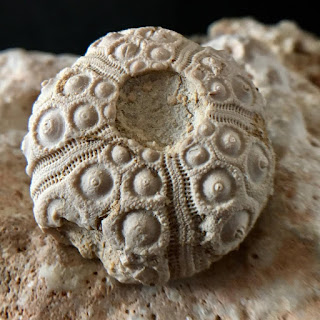Cretaceous sea urchin Dorocidaris taouzensis Lambert 1933 from Taouz (Morocco) (Photo by Jordi Sanchez).
Have you ever stopped to admire the intricate beauty of a sea urchin? Beneath its spiny exterior lies a world of complexity and adaptation. One of the most fascinating features of these echinoderms is their ambulacra, radial areas on their shell that contain tiny pores through which their tube feet extend, allowing them to move and feed.
The Enigma of Crossed Ambulacra
Normally, these pores are arranged in parallel rows, forming a precise geometric pattern. However, in some individuals, these rows deviate from their usual course and intersect, forming a kind of "X". This peculiarity, known as crossed ambulacra, has puzzled scientists for years.
Crossed ambulacrum (IV) of a cretaceous sea urchin Micraster sp from Lleida (Catalonia) (Photo by Jordi Sanchez).
What Causes This Strange Malformation?
The exact causes of crossed ambulacra are not yet fully understood, but several hypotheses have been proposed:
- Post-trauma regeneration: If a sea urchin suffers an injury to its shell, during the regeneration process, the new structures may form irregularly, resulting in crossed ambulacra.
- Genetic factors: Mutations in the genes that control the development of the skeleton can cause alterations in the arrangement of the pores.
- Diseases and parasites: Certain infections or parasites can interfere with the normal growth of the sea urchin and cause these malformations.
- Environmental factors: Water pollution, changes in temperature, or salinity can affect the development of the sea urchin's skeleton and lead to crossed ambulacra.
Why Are Crossed Ambulacra Important?
The study of crossed ambulacra is not only intellectually stimulating but also has significant scientific implications:
- Paleontology: In sea urchin fossils, crossed ambulacra can provide clues about past environmental and biological conditions. For example, they may indicate events of environmental stress, such as sudden changes in temperature or salinity, or even the presence of predators.
- Developmental biology: Studying these anomalies helps us better understand the processes of development and regeneration in organisms.
- Evolution: They reveal information about the morphological plasticity of sea urchins and how they adapt to different environments.
- Conservation: By understanding the causes of malformations, we can identify potential threats to sea urchin populations and take measures to protect them.
Implications for Conservation
The presence of crossed ambulacra in a sea urchin population may be an indicator of environmental or genetic problems. By monitoring the frequency of these malformations, scientists can detect changes in marine ecosystems and take steps to mitigate them.




%20Cleoniceras%20aff%20besairiei%20(Collingion,%201949)%20from%20Madagascar..Discovered%20in%20the%20Mahajanga%20province%20of%20Madagascar,%20these%20ammonites%20have%20taken%20on%20a%20brilliant,%20rainbow%20iridescence.%20Th-2.jpg)
%20sea%20urchin%20Micraster%20coranguinum%20Leske,%201778%20from%20Lleida%20(Catalonia)..%20Fossil%20in%20situ.%20Fossil%20preparation%20with%20water%20and%20toothbrush.%20Fossil%20preparation%20through%20chemical%20treatment%20using%20pot.jpg)
